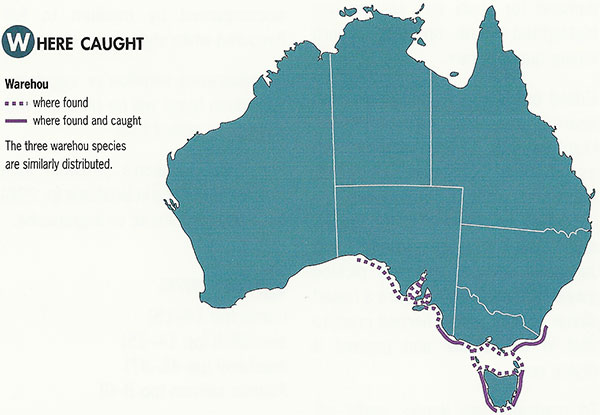Warehous have a thick fillet with very few bones.
Warehous are delicious when marinated, then either grilled and served with chilli jam, or deep fried and served with chips.
Catch limits
| Catch limit | Fishing Mortality* | Biomass** |
|---|---|---|
Catch Limit 350 tonnes For the 2025–26 Season | G;Not subject to overfishing | G;Not overfished |
* Fishing mortality status relates to the level of fishing pressure on a stock – specifically, whether fishing mortality in the year being assessed is likely to result in the stock becoming overfished or prevent the stock from rebuilding from an overfished state. If fishing mortality exceeds either of these thresholds, a stock is considered to be subject to overfishing.
** Biomass status relates to how many fish there are – specifically, whether the biomass in the year being assessed is above the level at which the risk to the stock is considered to be unacceptable. The HSP defines this level as the limit reference point, below which the stock is considered to be overfished.
Scientific name: Seriolella punctata
Family: Centrolophidae
Other names: Spotted warehou, spotted trevally, spotted trevalla, snotty nose trevally, trevally, mackerel trevalla
Description: Silver warehou are medium-sized fish with relatively slender bodies. The body is bluish grey above and silvery below, with many spots along the sides. There is a dark bar-shaped blotch above the pectoral fin.
Size (length and weight): Up to 70 cm in length and 5.5 kg. Commonly found at 35‑55 cm in length and 0.4‑2.2 kg.
Life span: Up to at least 15 years.
Habitat: Silver warehou are a bottom-dwelling species that occurs on the continental shelf and slope. They can be found at depth of 50‑600 metres. Adults are usually demersal, with juveniles occurring offshore. Older juveniles move inshore and are often found in bays and inlets. Once mature, fish move out into deeper water. Silver warehou are a schooling species that aggregates to feed and spawn.
Prey: Pelagic invertebrates, such as pyrosomes and other tunicates.
Predators: Marine mammals, larger fish, sharks and seabirds.
Reproduction: Silver warehou reach reproductive maturity at about 4 years of age. Spawning occurs in late winter-early spring, with some variation in timing depending on location. Females produce up to about 1.6 million eggs each spawning season.
| Fishery found in | Gear used | Catch of this species is targeted or incidental |
|---|---|---|
| Southern and Eastern Scalefish and Shark Fishery – Commonwealth Trawl Sector | Bottom trawl | Targeted |
The Commonwealth catch of silver warehou is managed by quota, meaning that the catch of this fish by commercial fishers is restricted by weight.
Commercial fishermen are required to fill in records of their catches, during each fishing trip and when they land their catch in a port. This helps us keep records of how much is being caught.
AFMA decide on the amount that can be caught each year from expert advice and recommendations from fisheries managers, industry members, scientist and researchers.
For information about silver warehou stock assessments, refer to the Silver Warehou stock assessment 2018 report.
Silver warehou are found along the south east Australian coast from South Australia to New South Wales and Tasmania.
Silver warehou are predominantly caught in the Commonwealth Trawl Sector of the Southern and Eastern Scalefish and Shark Fishery. They are most commonly caught between 100 and 700 metres.

The main fishing method used to catch silver warehou is bottom trawl in the Commonwealth Trawl Sector.
Sometimes, bottom trawling can catch unwanted species of fish (not the type of fish the net was supposed to catch). This is known as bycatch and it is monitored by on-board fishery observers who assess the environmental impact of the trawling.
Although it is not physically possible to trawl on reef structures, significant long-term damage can occur if sensitive habitat areas like corals, sponges and seagrass beds are trawled. To ensure these sensitive habitat areas are protected from trawling, management arrangements such as area closures are extensively used.
AFMA’s management of commercial trawl fisheries aims to ensure trawl fishing has the least impact possible on the environment.